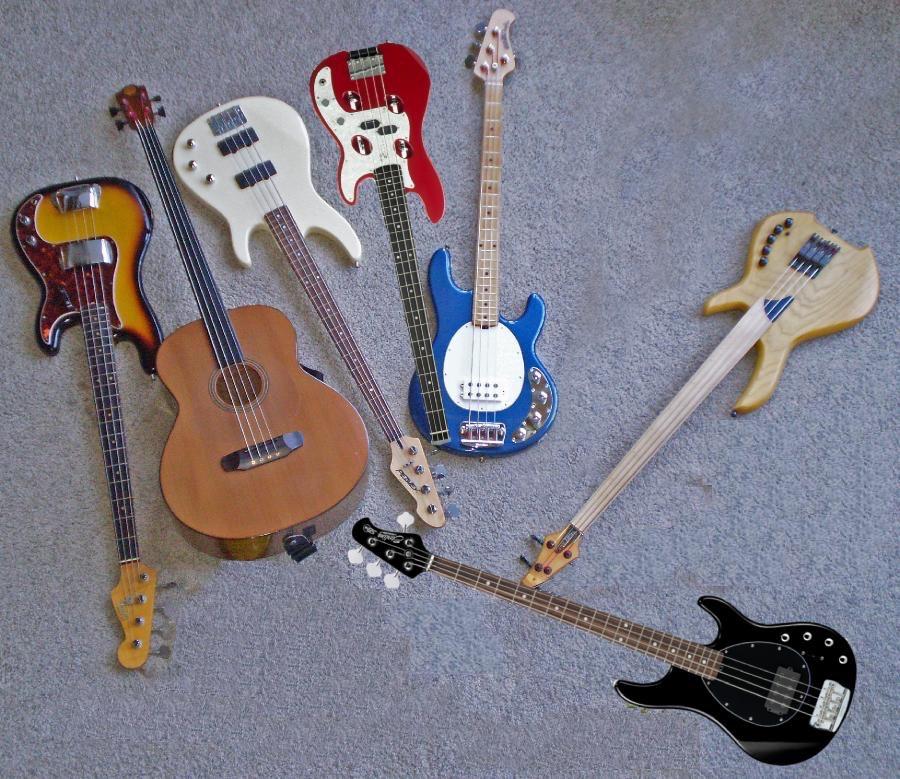My basses all have a different feel and playing character to them. This helps to push me in different playing directions depending on which instrument I'm using. Clockwise from upper left: 1965 Fender P, Maize fretless, Peavey Foundation fretless, Traveler Guitars bass, Stingray, Lightwave Sabre, Sterling by Musicman SB14.
1995 Peavey Foundation, lined fretless
I bought this new in 1996 as a replacement for the Pedulla Buzz when that disappeared from a birthday-jam party in August 1996. (The happy ending is that the Pedulla was taken accidentally by another player; its case looked like one of his, and the instrument ended up in storage for 13 months. When I got it back I paid back the insurance company.) Weighs 8lb10oz.
This instrument plays wonderfully and has a deep, solid fretless tone. Typically with a mass-produced instrument — especially one at a low price point — there can be quite a variation between instruments. I was lucky to have found a great one. With its passive soapbar pickups, it's like a fretless Fender Jazz on steroids. Passive controls are volume/volume/tone like a Fender Jazz. Strings: D'Addario SHR71 halfrounds (now discontinued).
2003 Lightwave Saber C, unlined fretless
I bought this bass used in December 2006. This bass is unique because it uses an optical pickup system; there are no magnetic pickups at all. There are also piezo pickups in the bridge, which can be blended with the optical output. Active controls are volume/bass/mid/treble, and "Ice Tone" piezo level. A toggle switch alters the tone much like a neck/bridge pickup selector. Weighs 7lb2oz.
Strung with Thomastik-Infeld JF344 flatwounds, the bass has a bit of an upright tone. They're low-tension strings, so it isn't an instrument for digging in hard.
For further info about the instrument, see the Lightwave web site.
1994 Dave Maize acoustic bass, unlined fretless
This hand-made instrument looks and sounds beautiful; it was bought new direct from Dave's shop. This instrument, bought new in 1995, was one he had just completed. It has a nice, full acoustic sound and also sounds great when amplified. Weighs 6lb14oz. Strings: Rounds but I forget which ones.
The pickup is the active Highlander system, originally designed by Rick Turner (and others?) with no controls at the instrument.
The woods are a redwood top, Oregon black walnut sides & back, black tuners and bridge saddle. The fingerboard is made from black phenolic. It has the newer Highlander IP-2 preamp, which has a second channel for an optional internal microphone.
Dave Maize's fretted bass was reviewed in Bass Player magazine, in the December 1993 issue. Read my review and view more photos of the fretted model.
1965 Fender Precision
This bass, with an original October-1964 "C" neck, was built in early 1965, making it one of the last ones made before CBS began making changes to the company. The factory often stockpiled finished necks for several months, using one of those necks to complete an instrument. The serial number suggests this instrument was completed in the first quarter of 1965.
I bought this bass used in 1973, when it was included with a used VOX Essex bass amp I was buying. I didn't really think I needed a bass — what I needed at the time was the amplifier — but I bought the pair. I sold the amp about ten years later, and naturally kept the bass. This has turned out to be one of the better purchase decisions I've ever made. Weighs 9lb exactly. Passive controls are volume and tone.
When I got the bass, it had a poorly-done white refinish job. In 1976, I stripped it and applied a natural mahogany stain and black pickguard (somewhat like a Gibson EB0 with a satin finish). It plays smoothly and quietly, with a nice low action. This instrument still occasionally surprises me with the sheer power of its oritinal pickups, especially when recording. (As of this writing in March 2025, they're 60 years old!)
In August 2006, I had it professionally stripped and refinished in a faded early-60s sunburst, I restored the original tortoise pickguard, and it got some light "relic" aging. The refinish, done by Mark Jenny, is documented on my Fender Bass Refinish page. Strings: SIT Power Flats.
2002 Musicman Stingray
Bought used in June 2009. This bass left the factory on 11 Jul 2002 and was shipped to Edmonton, Alberta, Canada. It was later traded to a player in central Texas. In June 2009 it pretty much came home; I live 38 miles from the Musicman factory! Active controls are volume/bass/mid/treble. Weighs 9lb8oz. Strings: SIT Power Flats.
This bass is a monster tone machine! Why did it take me almost forty years to try one? At one of my first gigs with it, I played like never before. I had been working on two-note chords on the D/G strings, and with the Stingray they seemed easier than usual. With minor adjustments to the tone controls (especially the midrange) and right-hand position, I can get whatever tone I want. With boosted mids, that Stingray growl jumps right out onstage. By boosting bass a tad and playing nearer the neck, I can get a vintage tone, even a decent upright-like thump.
The oddest thing to me was that I began fretting notes with my pinky, which I've never done since I began playing in 1970! That's going to improve my playing.
2013 Sterling By MusicMan SB14
I got this in a trade in December 2014. It's black with a rosewood fretboard. Not as pretty as I'd like, but the price was right and it certainly plays and sounds like my Stingray. Weighs 9lb7oz. Strings: SIT Power Flats.
Traveler Guitar Bass
This little headless red bass has a full 32" scale! With the standard Seymour Duncan pickups, it sounds surprisingly like a good Fender Precision. It weighs in at 6lb8oz. Strings: Original rounds.
|

